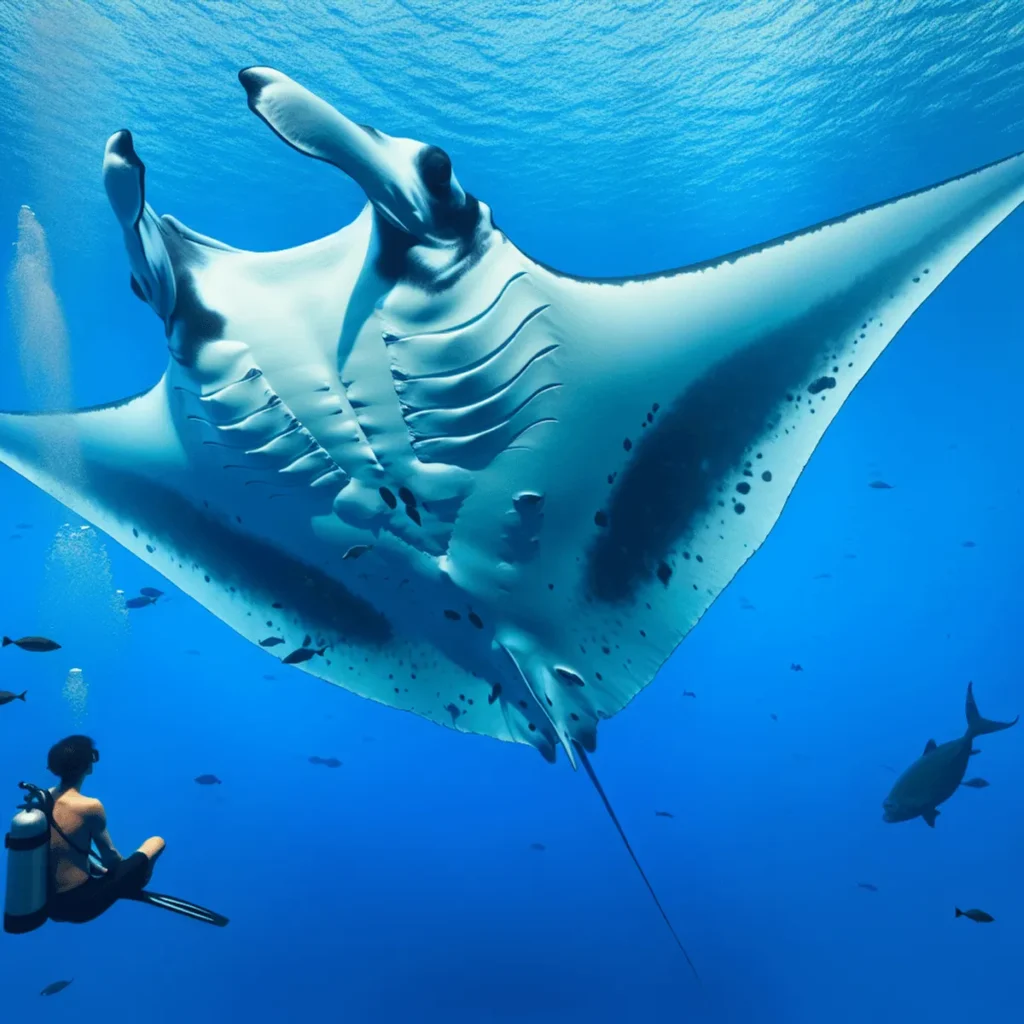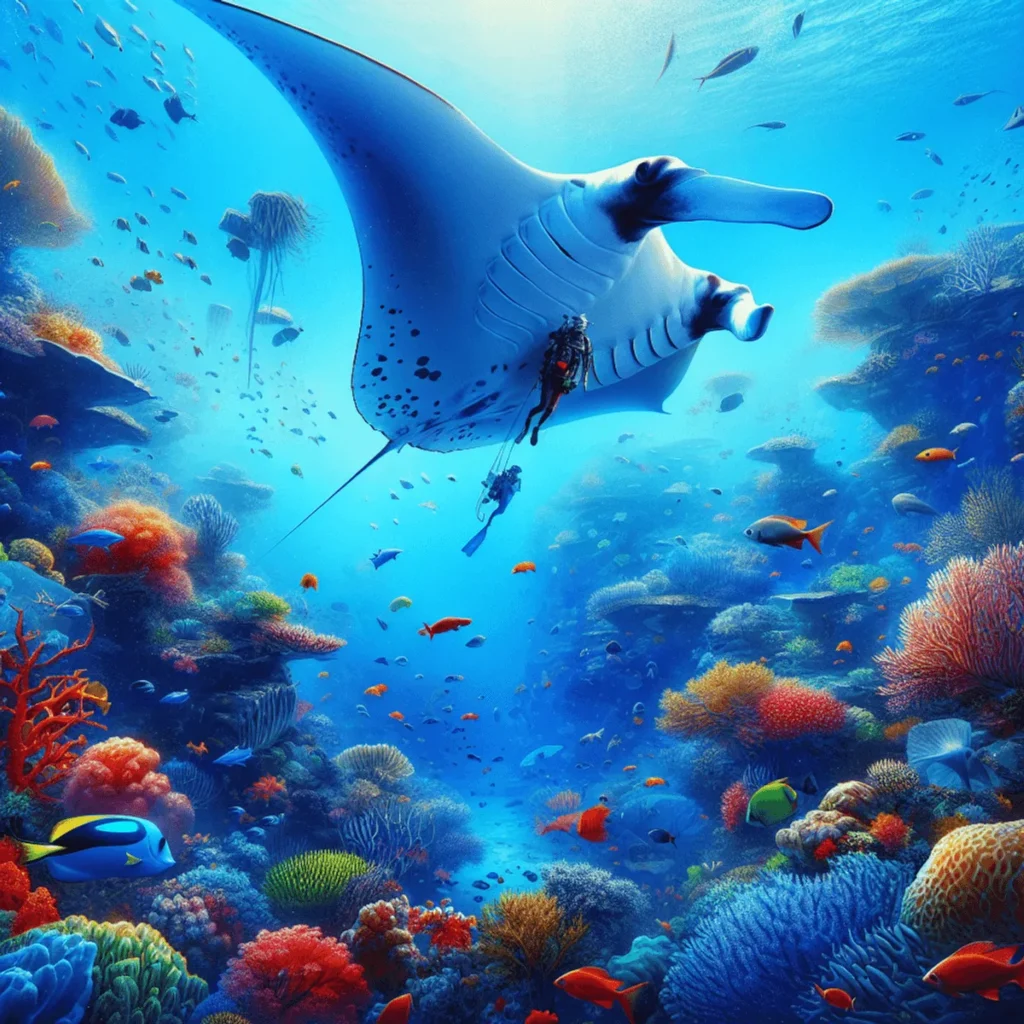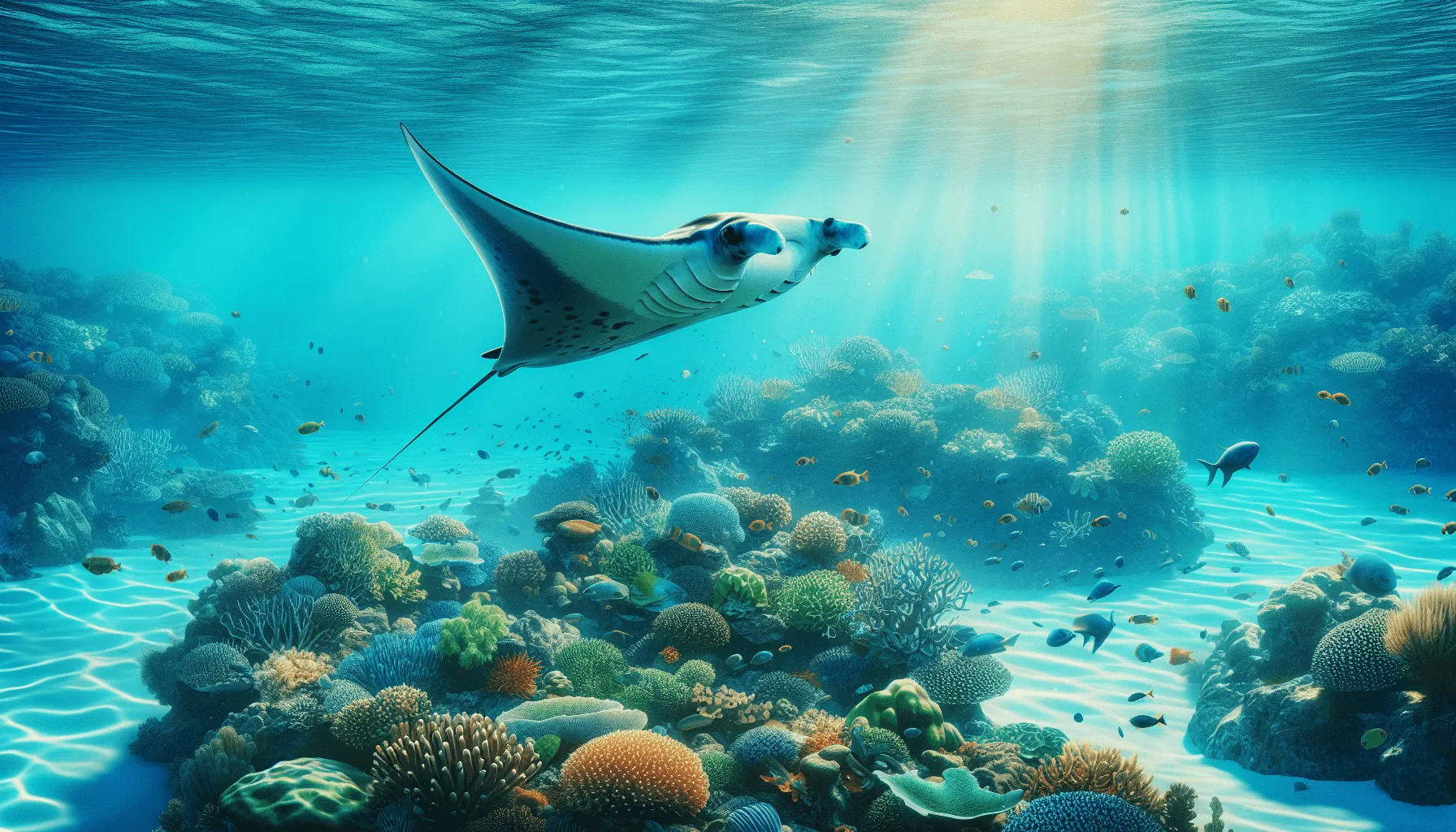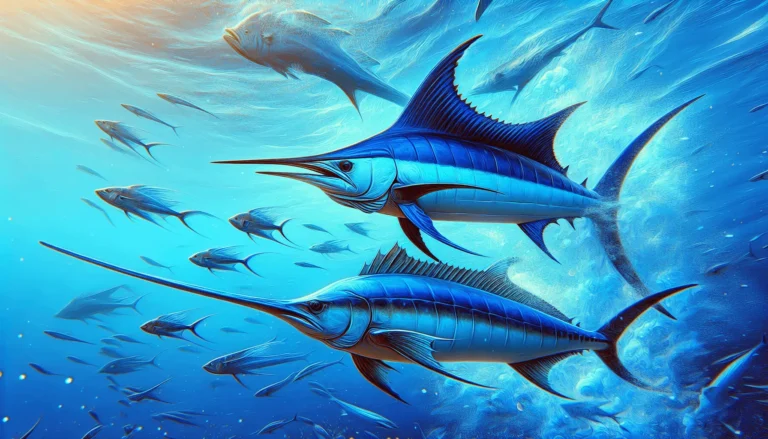Manta rays and stingrays are fascinating creatures belonging to the order Myliobatiformes, within the superorder Batoidea. These species, while related, have many differences in their physical traits, habitats, feeding habits, lifespan, intelligence, and behavior towards humans.
Key Differences:
- Physical Characteristics: Manta rays are easily identified by their lack of a tail barb and massive pectoral fins. Stingrays possess venomous spines on their tails.
- Habitat Preferences: Manta rays thrive in tropical and subtropical open oceans or reefs. Stingrays prefer shallow coastal areas and freshwater rivers.
- Feeding Habits: Manta rays filter-feed on zooplankton. Stingrays are bottom-feeders, consuming mollusks and small fish.
- Lifespan: Manta rays can live up to 50 years. Stingrays typically have a lifespan ranging from 15 to 25 years.
- Intelligence: Manta rays display high levels of intelligence, including self-recognition. Stingrays show simpler behaviors but can manipulate objects for food.
- Behavior Towards Humans: Manta rays are often curious about humans and pose no threat due to their lack of a tail barb. Stingrays tend to avoid humans but can become defensive if threatened.
Understanding these differences enhances our appreciation of these marine species and underscores the importance of their conservation.
1. Taxonomy and Classification
To understand how manta rays and stingrays are classified, we need to start with the order Myliobatiformes, which is a group within the larger superorder Batoidea. This order includes different species that have similar evolutionary features, like flat bodies and long pectoral fins.
Families of Manta Rays and Stingrays

Manta Rays
Manta rays belong to the family Mobulidae. This family includes both manta rays and devil rays, which are known for their large size and filter-feeding behavior.
Stingrays
Stingrays can be found in several families, mainly Myliobatidae and Dasyatidae. These families include a wide range of stingray species that are recognized for their venomous tail spines.
Related Families
The order Myliobatiformes also includes other related families:
- Hexatrygonidae: Known as sixgill stingrays, these species are notable for their unique gill structure.
- Urolophidae: Commonly referred to as round rays, they are distinguished by their rounded pectoral disc.
Each family within this order helps us understand the diversity and specialization of these amazing marine creatures.
Read Also: Epic Battle: Marlin vs. Swordfish – Who Wins?
2. Size Comparison
When comparing the sizes of manta rays and stingrays, distinct differences emerge.
Average Sizes
- Manta Rays: These majestic creatures can reach impressive widths. On average, manta rays span up to 23 feet wide and can weigh as much as 2,980 pounds.
- Stingrays: Generally smaller in comparison, stingrays typically measure around 6 feet in width at their largest.
Notable Species Sizes
- Reef Manta Ray: This species of manta ray can grow up to 18 feet wide. Their significant size makes them easily distinguishable in the ocean.
- Atlantic Stingray: One of the smaller representatives within stingrays, the Atlantic stingray usually reaches up to 2 feet in width.
The significant difference in size between these species is a defining feature. While both belong to the same order, their physical dimensions set them apart significantly.
3. Physical Characteristics
Manta rays and stingrays, while related, have significant differences in their physical characteristics.
Distinct Features
Manta Rays
Known for their lack of a tail barb, manta rays are generally harmless to humans. This absence of a venomous spine distinguishes them from many other ray species.
Read Also: The Fascinating Names for Groups of Fish | Schools vs. Shoals
Stingrays
Equipped with a venomous spine on their tails, stingrays can deliver painful stings. The short-tail stingray is one example that possesses this notable feature, making them more defensive when threatened.
Body Shapes and Movement Styles

Manta Rays
Possessing large, triangular pectoral fins, manta rays have a flattened body shape that allows for efficient propulsion. Their movement often resembles the graceful flight of birds through water.
Stingrays
Typically featuring a more rounded or diamond-shaped body, stingrays utilize an undulating motion to navigate their environment. This wave-like movement helps them stay close to the seabed where they often forage for food.
The physical differences between these two groups are not just surface-level but also reflect their different lifestyles and adaptations to their environments.
Read Also: Fishing Showdown – Largemouth Bass vs Smallmouth Bass
4. Habitat Preferences
Manta rays and stingrays live in different environments, which reflects their unique adaptations and roles in the ecosystem.
Manta Rays:
- Open Ocean: Manta rays are often seen in the open ocean, gracefully swimming through vast areas of water.
- Reefs: They also visit coral reefs, where they can find plenty of plankton to eat.
Stingrays:
- Coastal Areas: Stingrays usually live in shallow coastal waters, often hiding in sandy or muddy bottoms.
- Freshwater Rivers: Some species of stingrays have adapted to freshwater habitats, thriving in rivers and estuaries.
These different habitats show the wide range of lifestyles and ecological roles that manta rays and stingrays have.
5. Feeding Habits
Understanding the feeding habits of manta rays and stingrays reveals significant differences in their diets and foraging behaviors.
Manta Ray Diet
- Filter-feeding: Manta rays are filter feeders, primarily consuming zooplankton, which includes tiny organisms like krill, shrimp, and microscopic plants.
- Feeding technique: They swim with their large mouths open to funnel water through specialized gill rakers that trap plankton.
- Habitat influence: Their diet is influenced by their habitat in the open ocean where plankton is abundant.
Stingray Diet
- Bottom-feeding: Stingrays are bottom feeders, preying on mollusks, small fish, worms, and crustaceans.
- Feeding technique: They use their flattened bodies to disturb the sand and uncover hidden prey, employing a suction-like mechanism to ingest food.
- Habitat influence: Coastal areas and riverbeds provide an ample supply of benthic organisms for their diet.
These distinct feeding strategies highlight how each species has adapted to its environment for optimal survival.
6. Lifespan and Growth
Manta rays live much longer than stingrays. Manta rays can live up to 50 years, which is due to their larger size and ocean-dwelling lifestyle. They grow slowly, taking years to reach their full wingspan of up to 23 feet. This long lifespan allows them to mature and reproduce multiple times, helping them survive in the wild.
On the other hand, stingrays usually live for about 15 to 25 years. Their lifespan varies by species but is generally shorter than that of manta rays. Stingrays grow faster and reach maturity relatively quickly compared to their larger relatives. Their growth and development are suited to their coastal habitats where they face different environmental challenges.
This difference in lifespans shows how these fascinating creatures have evolved different strategies for survival.
7. Intelligence and Behavior Towards Humans

The intelligence of manta rays and stingrays reveals fascinating differences.
Manta Rays
Manta rays are known for their high intelligence, showing behaviors like self-recognition—a rare trait in the marine world. Studies have found that manta rays have the largest brain-to-body ratio among fish, which supports their complex thinking abilities.
- Manta rays often show curiosity towards humans, engaging in playful interactions without being aggressive.
- They can solve problems and learn socially, making them one of the smartest species in the ocean.
Stingrays
Stingrays, while not as intellectually advanced as manta rays, still show notable behaviors. They can manipulate objects to get food and display a basic level of problem-solving skills.
- Stingrays tend to be more solitary compared to the social nature of manta rays.
- Although generally avoiding human contact, stingrays may become defensive if they feel threatened, using their venomous spines as protection.
These differences highlight the unique ways each species interacts with their environment and humans, emphasizing their distinct evolutionary paths within the order Myliobatiformes.
Read Also: Which is Better? British vs American Fly Fishing
8. Reproductive Strategies
Mating Rituals of Manta Rays and Stingrays
Manta rays and stingrays have their own unique ways of attracting mates, each reflecting their different reproductive strategies.
Manta Rays
- Males perform acrobatic displays, following females in a synchronized swimming pattern called the “mating train.”
- The males compete to stay closest to the female, showing off their agility and endurance.
- When the female chooses a mate, the selected male grabs her pectoral fins to ensure successful fertilization.
Stingrays
- Courtship involves biting behavior, where males bite the edges of the female’s disc or fins.
- Biting helps males hold onto females during copulation.
- Female stingrays show acceptance by stopping their struggle, allowing the male to complete the mating process.
These different approaches highlight how manta rays and stingrays have evolved in their own ways to overcome environmental challenges and ensure successful reproduction.
9. Conservation Status
Both manta rays and stingrays face threats from human activities, including:
- Fishing Practices: Both manta rays and stingrays are often caught as bycatch in commercial fishing operations. Manta rays are particularly vulnerable due to their large size and slow reproductive rates. Stingrays, on the other hand, are sometimes targeted for their meat, skin, and cartilage.
- Habitat Loss: Coastal development and pollution have degraded the natural habitats of stingrays, making it difficult for them to find safe breeding grounds and sufficient food. Manta rays are affected by changes in ocean conditions such as temperature shifts and coral reef destruction.
Conservation of Manta Rays and Stingrays

Efforts to protect these species include:
- Protected Areas: Establishing marine protected areas (MPAs) helps preserve critical habitats.
- Fishing Regulations: Implementing sustainable fishing practices and stricter regulations can reduce bycatch.
- Public Awareness: Educating communities about the importance of these species in marine ecosystems fosters support for conservation initiatives.
Additionally, the plight of other marine species, such as the green turtle, highlights the broader impact of human activities on ocean life. Understanding the challenges faced by both manta rays and stingrays is crucial for developing effective conservation strategies.
Conclusion
Raising awareness about the unique qualities and conservation needs of both manta rays and stingrays is essential for preserving these amazing species. Understanding their differences – from physical traits to habitat preferences and behavior – can inspire appreciation and motivate protective actions.
We encourage you to explore more about marine life, expanding your knowledge and supporting informed conservation efforts. Whether you want to compare manta rays and stingrays or simply discover the wonders of the ocean, every bit of awareness helps ensure their survival.
FAQs (Frequently Asked Questions)
What are the main differences between manta rays and stingrays?
Manta rays and stingrays differ in several key aspects: physical characteristics (manta rays lack a tail barb while stingrays possess a venomous spine), habitat preferences (manta rays inhabit open oceans and reefs, whereas stingrays are found in coastal areas and freshwater rivers), feeding habits (manta rays filter-feed on zooplankton, while stingrays bottom-feed on mollusks and small fish), and lifespan (manta rays can live up to 50 years, compared to 15-25 years for stingrays).
How are manta rays and stingrays classified?
Both manta rays and stingrays belong to the order Myliobatiformes. Manta rays are classified under the family Mobulidae, while stingrays fall under the family Myliobatidae, among others. Other related families include Hexatrygonidae and Urolophidae.
What is the typical size of manta rays compared to stingrays?
Manta rays generally grow larger than most species of stingrays. For example, reef manta rays can reach sizes of up to 23 feet across, while Atlantic stingrays typically measure around 3-4 feet in width. Size varies significantly among species within each group.
What are the feeding habits of manta rays and stingrays?
Manta rays are filter feeders that primarily consume zooplankton by filtering it from the water as they swim. In contrast, stingrays are bottom feeders that hunt for mollusks and small fish buried in the sand.
How long do manta rays and stingrays live?
Manta rays have a longer lifespan, living up to about 50 years, while stingrays typically live between 15 to 25 years depending on the species.
What threats do manta rays and stingrays face?
Both manta rays and stingrays face significant threats due to human activities such as fishing practices that target them directly or indirectly, habitat loss from coastal development, and pollution. Conservation efforts are crucial for their survival.



